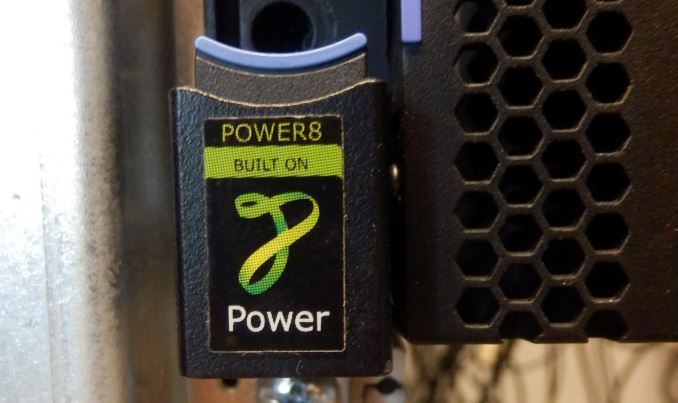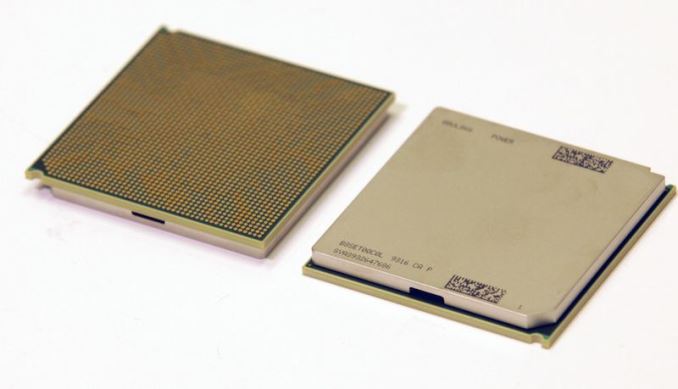The IBM POWER8 Review: Challenging the Intel Xeon
by Johan De Gelas on November 6, 2015 8:00 AM EST- Posted in
- IT Computing
- CPUs
- Enterprise
- Enterprise CPUs
- IBM
- POWER
- POWER8
Comparing Benchmarks: AT vs IBM
Before we close things out, let's spend a moment summarizing our results and comparing the performance we saw to the kind of performance advantages that IBM advertises POWER8 is capable of.
From a high level perspective, the S822L is more expensive and consumes a lot more power than a comparable Xeon system.
With limited optimization and with the current Ubuntu 15.04, the performance-per-watt ratio favors Intel even more as the POWER8 barely outperforms the very efficient 120W TDP Xeons. So there is no denying that the Intel systems offer a superior performance/watt ratio.
However, it would be unfair to base our judgement on our first attempt as we have to admit this our first real attempt to benchmark and test the POWER8 platform. It is very likely that we will manage to extract quite a bit more performance out of the system on our second attempt. IBM POWER8 also has a big advantage in memory bandwidth. But we did not manage to port OpenFOAM to the POWER platform, probably the most likely candidate for leveraging that advantage.
We are less convinced that the POWER8 platform has a huge "raw CPU compute advantage," contrary to what for example IBM's SPECJBB (85% faster ) and SAP (29% faster) results seem to suggest.
For example, IBM's own SPECjEnterprise®2010 benchmarking shows that:
- Two Xeon E5-2697 v3, 14 cores at 2.6-3.1 GHz score 19282
- Two POWER8, 12 cores at 3.5-3.8 GHz score 22543
SAP is "low IPC" (hard to run many instructions in parallel in one thread) software that benefits much from low latency caches. The massive L3-cache (12-cores, 96 MB) and huge thread count are probably giving the IBM POWER8 the edge. The RAM bandwidth also helps, but in a lesser degree. IBM clearly built POWER8 with this kind of software in mind. We had individual threadcount intensive benchmarks (LZMA decompression) and L3-cache sensitive benchmarks (ElasticSearch), but t o be fair to IBM, none of our benchmarks leveraged the three strongest points (threadcount, L3-cache size and memory bandwidth) all at once like SAP.
SPECJBB2013 has recently been discontinued as it was not reliable enough. We tend to trust the jEnterprise test a lot more. In any case, the best POWER8 has a 17% advantage there.
Considering that the POWER8 inside that S824 has 20% more cores and a 3% higher clockspeed, our 3.4 GHz 10-core CPU would probably be slightly behind the Xeon E5-2697 v3. We found out that the 10-core POWER8 is slightly faster than Xeon E5-2695 v3. The Xeon E5-2695 v3 is very similar to the E5-2697 v3, it is just running at a 10% lower clockspeed (All core turbo: 2.8GHz vs 3.1GHz). So all in all, our benchmarks seems to be close to the official benchmarks, albeit slightly lower.
Closing Thoughts: A Mix of Xeon "E5" and "E7"
So let's sum things up. The IBM S822L is definitely not a good choice for those looking to lower their energy bills or operate in a location with limited cooling. The pricing of the CDIMMs causes it to be more expensive than a comparable Xeon E5 based server. However, you get something in return: the CDIMMs should offer higher reliability and are more similar to the memory subsystem of the E7 than the E5. Also, PCIe adapters are hot-pluggable on the S822L and can be replaced without bringing down the system. With most Xeon E5 systems, only disks, fans and PSU are hot-pluggable.
In a number of ways then, the S822L is more a competitor to dual Xeon E7 systems than it is to dual Xeon E5 systems. In fact, a dual Xeon E7 server consumes in the 600-700W range, and in that scenario the power usage of S822L (700-800W) does not seem outrageous anymore.
The extra reliability is definitely a bonus when running real time data analytics or virtualization. A failing memory chip may cost a lot when you running fifty virtual machines on top of a server. Even in some HPC or batch data analytics applications where you have to wait for hours for a certain result that is being computed in an enormous amount of memory, the cost savings of being able to survive a failing memory chip might be considerable.
One more thing: for those who need full control, the fact that every layer in the software stack is open makes the S822L very attractive. For now, the available "OpenCompute" Xeon servers that are also "open" seem to mostly density optimized servers and the openess seems limited on several levels. Rackspace felt that the current OpenCompute servers are not "open enough", and went for OpenPOWER servers instead. In all those markets, the S822L is very interesting alternative to the dual Xeon E5 servers.
Ultimately however, the performance-per-dollar Xeon E5 competitors will most likely be OpenPOWER third party servers. Those servers do not use CDIMMS, but regular RDIMMs. Other components such as disks, networkcards and PSUs will probably be cheaper but potentially also slightly less reliable.
All in all, the arrival of OpenPOWER servers is much more exciting than most of us anticipated. Although the IBM POWER8 servers can not beat the performance/watt ratio of the Xeon, we now have a server processor that is not only cheaper than Intel's best Xeons, but that can also keep up with them. Combine that with the fact that IBM has lined up POWER8+ for next year and a whole range of server vendors is building their own POWER8 based servers, and we have a lot to look forward to!












146 Comments
View All Comments
Michael Bay - Saturday, November 7, 2015 - link
You are probably still hurry.Or just not civilized enough.
JohanAnandtech - Saturday, November 7, 2015 - link
I have to disagree with "only old legacy". One of things I really want to tackle is running Apache Spark on POWER. Spark is one of the most exciting Big Data tools, it is a very modern piece of software. IBM claims that the POWER8 is very good at it, and I want to check that.Jake Hamby - Friday, November 6, 2015 - link
Very interesting review! I've been a PowerPC fan for many years. I even bought a used PowerMac Quad G5 a few years ago to hack on FreeBSD for PowerPC with (much cheaper than the latest gear).My only suggestion is that I would love to see you run the same benchmarks with big-endian Linux, since the entire stack is so much more mature for PPC than LE Linux, which as you mention wasn't even supported for many years.
Anyone running Java workloads in particular has no business using LE Linux when Java itself uses big-endian data formats, and IBM has 15+ years of tuning the JDK for big-endian Linux & AIX.
TL;DR is the biggest advantage of LE Linux is that it's easier to port large custom apps that were written for x86 and have too many byte ordering issues to fix. The original motivation to make the PowerPC architecture bi-endian instead of big-endian was the hope of a Windows NT port. When Apple went their own way with hardware, and IBM focused on servers, little-endian mode disappeared. It's good that POWER8 supports LE mode again, for customers who really need it, but it's far from the normal mode.
PS. I've been working on fixing bugs in Clang/LLVM for PowerPC arch (32/64-bit). FreeBSD recently switched from GCC 4.2.1 (final GPLv2 version) to Clang as the default system compiler on x86, but LLVM has some code gen bugs for PowerPC that I'm hoping to squash. For now, it doesn't work well enough for me to recommend trying to use Clang as an alternative to GCC for POWER8 benchmarking. Certainly not for little-endian mode.
Jake Hamby - Friday, November 6, 2015 - link
BTW, the name of the instruction set architecture is still PowerPC, even though IBM's chips are the POWER series. The predecessor architecture was named POWER, so I always write PowerPC to avoid confusion when referring to the instruction set. The PowerPC 970MP chips in my Quad G5 (2 x dual-core) are a derivative of POWER4.ZeDestructor - Saturday, November 7, 2015 - link
That would be incorrect actually (since they changed since in 2006).The ISA is (currently) named the Power ISA (previously "PowerPC ISA", the "ISA" bit is quite important to denote hardware architecture vs ISA) (with the current being Power ISA 2.07 B)
Underneath each ISA, there are a variety of designs that all have nice, different names, from POWER1-8, PowerPC (including the various variants used by Apple, like the G5/970), Power-PC-AS, Cell, most LSI controllers (mostly PowerPC 440 (Power ISA 2.03) based, afaik) etc.
Source: https://en.wikipedia.org/wiki/Power_Architecture
tipoo - Friday, November 6, 2015 - link
I wish I had a what-if machine to see what IBM would be making had they stayed in the consumer space (well, discounting some consoles they're in - currently only the Wii U on an ancient PowerPC 750 modified for tri-core). And how chunky that PowerBook G5 would have been :Phttp://forums.macrumors.com/attachments/powerbook_...
DanNeely - Friday, November 6, 2015 - link
Probably they'd've ended up making architectural tradeoffs that made their cores a lot more like Intel. As it is, they can optimize their designs for very high power isn't a problem because the power cost is a small fraction of the TCO on one of their monster servers; and a relatively minor concern for consoles (ie just dropping the core count gets them desktop CPU level thermals which are good enough). If they were still selling to Apple, they'd need to be well optimized for performance at only a few watts/core for laptops. Huge L1 caches and massive SMT would be gone because they'd devour battery power to little benefit on systems that generally functioned at very low average CPU loads vs on a mega server or mainframe where if you're not pushing enough work onto it to keep it at a high load level you're doing it wrong.Jake Hamby - Friday, November 6, 2015 - link
Yep. It feels a lot like Apple's own 64-bit ARM cores have approached the old G5 (PPC 970) from the other end of the power envelope.Kevin G - Saturday, November 7, 2015 - link
While Apple's engineers were given the task of a PowerBook G5, they new it could never happen due to thermals and a very arcane chipset. Case in point, the PowerPC 970 could not boot itself: it needed a service processor to calibrate and initialize the frontside bus for the processor before it could take control. Justifiable for servers but unnecessary for a consumer laptop.The expected Powerbook G5's were supposed to be using PA-Semi chips. Due to IBM not meeting Apple's goals, they switched to Intel and the PA-Semi deal fell through with it. However, their dealings with Apple did lead to Apply buying them out a few years later to help design custom ARM SoCs and eventually the custom ARM cores used in the iPhone/iPad of today.
JohanAnandtech - Saturday, November 7, 2015 - link
Would love to hear some thoughts on what the possible problems could arise if we rerun our tests on BE linux. Because our best benchmarks are all all based upon some data stored on our x86 fileservers - so they are probably stored in LE.